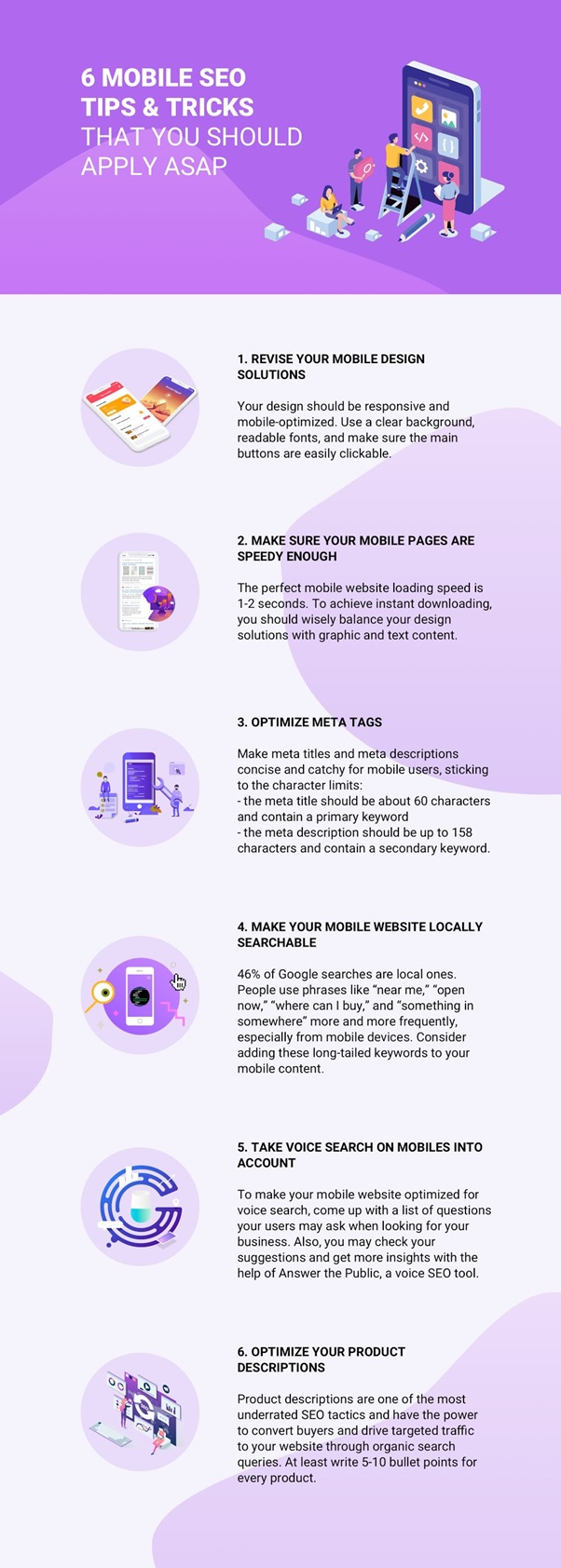While more than half of all online searches come from mobile devices, Google continues to develop recommendations for website owners on how to improve user experience on mobile devices and provide them with instant help.
The Mobile-First Index is the highest-priority guide to follow when building a website if your aim is to become perfectly visible from mobile devices and satisfy your users at the same time.
Below are the top tips for mobile SEO optimization which will help your website rank better on mobile search, and your users achieve the bottom of the sales funnel.
1. Start by revising your mobile design solutions
There is no point in SEO optimization if your mobile website is not user friendly. The mobile experience should be specific. That is why you should take the screen size, as well as the place and time of users interacting, when working on mobile design solutions.
Firstly, your design should be responsive, and secondly, it should be mobile-optimized. The user should be able to easily access all the necessary sections, get to the navigation menu, make an instant order, or get in touch with you from the Contact Us page.
Also, you should use an easy to perceive background, readable fonts, and main buttons that are easily clickable.
After you are done, do a mobile usability test. Google has a ready-made tool to help you. What’s more, after the check is completed, you will get firsthand insights into what to improve.
2. Make sure your mobile pages are speedy enough
The perfect mobile website loading speed is 1-2 seconds. For comparison, the pages accessed from the desktop are allowed to take up to 5 seconds to be fully downloaded. The difference is quite significant.
To achieve instant downloading, you should wisely balance your design solutions with graphic and text content.
To do it:
- use the images with lower resolution
- optimize your mobile content and leave only those pieces of text that are equally important for your users to find out what they want, and for search engines to index your page and match it with the relevant search query.
- check your website loading speed with Google Page Speed Insights, paying special attention to the mobile results.
3. Optimize your meta tags
Fortunately, there is nothing difficult with metadata optimization, except for one thing – you should make them especially concise and catchy for mobile devices.
Also, don’t forget about the character limits:
- Your meta title should be about 60 characters and contain a primary keyword.
- Your meta description should be 158 characters and contain a secondary keyword.
In addition, you can come up with several options and make an A/B testing to find out which option has a higher click-through-rate and attracts users better.
4. Make your mobile website locally searchable
46% of Google searches are local ones. People use phrases like “near me,” “open now,” “where can I buy,” and “something in somewhere” more and more frequently, especially from mobile devices. Consider adding these long-tailed keywords to your content.
Pro local SEO tips: Consider registering in Google My Business for better visibility at the top lines of local search results. Make sure you fill in as much business information as possible.
5. Take voice search on mobiles into account
Also, users tend to use voice search from mobiles. However, in this case, they search differently using the phrases that are used in everyday speech. For example, the local search query example from the previous tip (where can I buy something) is also an example of a voice search query.
To make your mobile website optimized for voice search, come up with a list of questions your users may ask when looking for your business. Also, you may check your suggestions and get more insights with the help of Answer the Public, a voice SEO tool.
6. Optimize your product descriptions
All the tips and tricks above are perfectly applicable to e-commerce sites. While developing your online shop, you also should follow the basic SEO writing rules, take voice and local search into account, and most importantly, kindly guide your customers through your sales funnel while paying the highest attention to your product descriptions.
As Matt Janaway, CEO of Marketing Labs states, “Product descriptions are one of the most underrated SEO tactics and have the power to convert buyers and drive targeted traffic to your website through organic search queries. At least write 5-10 bullet points for every product.”
And remember the main rule – you are not going to sell the goods. You are going to sell benefits and emotions. Make sure to highlight them in your descriptions. What’s more, coming up with the descriptions for your goods, you may enrich them with local and voice-specific keywords.
Conclusion
Mobile optimization is becoming more and more important as users demand answers to their questions and queries here and now. Developing a website without subsequent mobile optimization is no longer possible, since Google considers a positive mobile experience to be one of the key factors for ranking.
So, start implementing our mobile SEO tips right now to experience positive ranking changes and attract new mobile users asap!
Julia Kulik is a passionate digital marketing expert, spending her spare time on the production of in-depth guides to profitable B2B and B2C marketing.
SEO stock photo by chainarong06/Shutterstock








